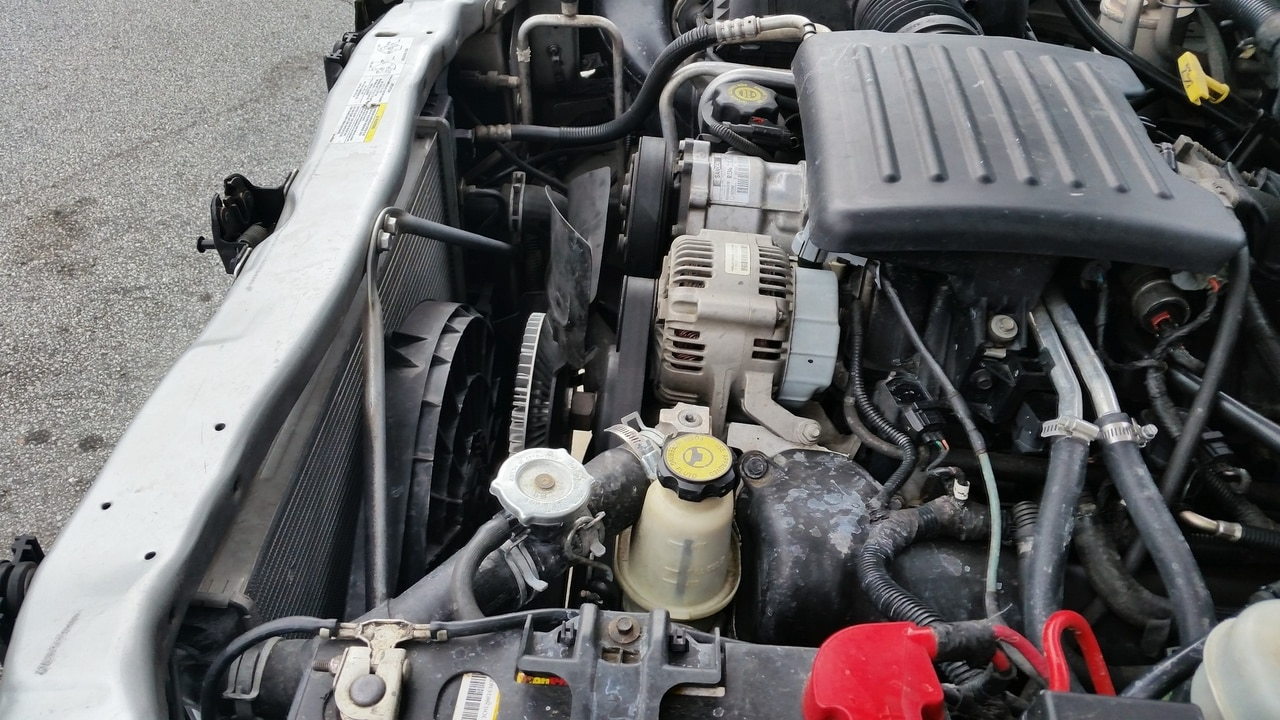P1491 Error code?
#1
I have a P1491 Check engine light code which states it's a "Radiator Fan Ctrl Relay Circuit". Forgive my simple minded thinking but, my fan is run by the serpentine belt and turns whenever the engine is running. I have just replaced the PCM so I'm wondering why I would get this code.
#6
#7
Trending Topics
#8
No extra fans, just the one behind the radiator, under the window washer reservoir atop the radiator. I know the fan isn't clutched because when I've had to remove/repair the AC compressor and Alternator, I had to move the fan blades to access bolts. Thanks again for the help.

RADIATOR FAN MOTOR
DIAGNOSIS AND TESTING—ELECTRIC COOLING FAN
The powertrain control module (PCM) will set a diagnostic trouble code (DTC) in memory if it detects a problem in the electric cooling fan relay or circuit.
RADIATOR FAN MOTOR INOPERATIVE
Equipment Required:
† DRB Scan Tool
† Volt/Ohm meter
† Wiring Diagrams
Test Procedure:
(1) Inspect 10A fuse in junction block and 40A max fuse in PDC.
(2) Remove Cooling Fan Relay from the PDC and make the following checks at the relay connector:
† Apply 12 volts (using a fused 14-gauge wire) to circuit C25 (relay terminal 87). If fan does not come on, check for open in circuit C25 or Z1. If circuits are o.k., replace the cooling fan motor.
† With the ignition key “off” check for battery voltage at circuit C28 (relay terminal 30). If no battery voltage present check for open/shorted circuit C28 between the PDC and relay.
† With the ignition key in the “run” position check for battery voltage at circuit F18 (relay terminal 86). If no battery voltage present, check for open/short in circuit.
If no problems are detected, install the DRB and start the engine. Clip a 12V test light to the battery positive terminal and probe circuit C27 (relay terminal 85). When the engine temperature reaches 110° C (230° F), or A/C is requested, the test light should light. If not, check circuit C27 for open.
† If no problems are detected at this point, replace the cooling fan relay.
RADIATOR FAN RELAY
DESCRIPTION
The radiator cooling fan relay is a 5–pin, solenoid type, mini-relay. It is located in the Power Distribution Center (PDC). Refer to label on PDC cover for relay location.
OPERATION
The electric radiator cooling fan is controlled by the Powertrain Control Module (PCM) through the radiator cooling fan relay. The PCM will activate the relay after receiving inputs from the engine coolant temperature
sensor and/or an air conditioning on/off signal.
Not Equipped with A/C: The relay is energized when coolant temperature is above approximately 103°C (217°F). It will then de-energize when coolant temperature drops to approximately 98°C (208°F).
Equipped with A/C: In addition to using coolant temperatures to control cooling fan operation, the cooling fan will also be engaged when the air conditioning system has been activated.
---------------------------------------------------------------------------------------
And the clutch fan if interested....
DIAGNOSIS AND TESTING - VISCOUS FAN DRIVE
If the fan assembly free-wheels without drag (the fan blades will revolve more than five turns when spun by hand), replace the fan drive. This spin test must be performed when the engine is cool.
For the following test, the cooling system must be in good condition. It also will ensure against excessively high coolant temperature.
WARNING: BE SURE THAT THERE IS ADEQUATE FAN BLADE CLEARANCE BEFORE DRILLING.
Drill a 3.18-mm (1/8-inch) diameter hole in the top center of the fan shroud.
Obtain a dial thermometer with an 8 inch stem (or equivalent). It should have a range of -18 - 105 °C (0 - 220 °F) . Insert thermometer through the hole in the shroud. Be sure that there is adequate clearance from the fan blades.
Connect a tachometer and an engine ignition timing light (timing light is to be used as a strobe light).
Block the air flow through the radiator. Secure a sheet of plastic in front of the radiator (or air conditioner condenser). Use tape at the top to secure the plastic and be sure that the air flow is blocked.
Be sure that the air conditioner (if equipped) is turned off.
WARNING: USE EXTREME CAUTION WHEN THE ENGINE IS OPERATING. DO NOT STAND IN A DIRECT LINE WITH THE FAN. DO NOT PUT YOUR HANDS NEAR THE PULLEYS, BELTS OR FAN. DO NOT WEAR LOOSE CLOTHING.
Start the engine and operate at 2400 rpm. Within ten minutes the air temperature (indicated on the dial thermometer) should be up to 93 °C (200 °F) . Fan drive engagement should have started to occur at between 91 - 96 °C (195 - 205 °F) . Engagement is distinguishable by a definite increase in fan flow noise (roaring). The timing light also will indicate an increase in the speed of the fan.
When the air temperature reaches 93 °C (200 °F) , remove the plastic sheet. Fan drive disengagement should have started to occur at between 62 - 85 °C (145 - 185 °F) . A definite decrease of fan flow noise (roaring) should be noticed. If not, replace the defective viscous fan drive unit.
----------------------------------------------------------------------------------------
Your code: https://www.engine-codes.com/p1491_dodge.html
#9
I'll be damned... I do have two fans. I have never noticed that before. I also looked at the Radiator Fan relay and it's a bit melted near the bottom (single blade). I'm guessing that's my problem. Thank you Dogevity for your picture and the diagnostic. From what I've read simply replacing the relay won't have any effect until the truck reaches temperature? Does this fan have another switch besides the relay? Also, beings that this is a code which I cannot clear with an OBD, does the check engine light go out once the PCM reads the relay correctly?
#10


